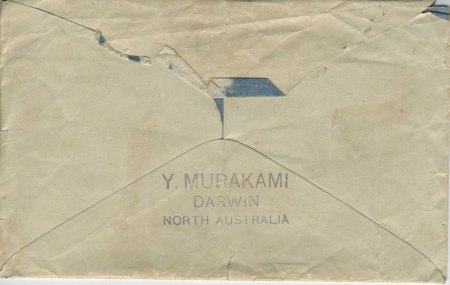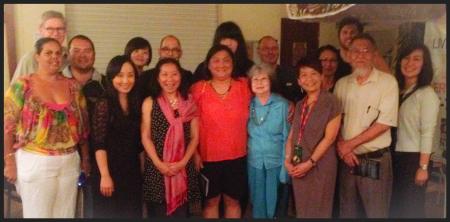Upon returning from photographing a wedding on Pearl Beach last weekend, I found a message from a man named Greg Leon in Melbourne:
I have just seen a news article at ABC Online… regarding Yasukichi Murakami and your biographical work on him. The article mentioned the scarcity of his photographs from his Darwin years. I have a set of 15 photographs that Mr Murakami may have taken of my parents when they were married in Darwin in May 1940. If you are interested please let me know… Regards, Greg
Interested?! This is what I’ve been doing for nearly 3 years: Looking for Yasukichi Murakami’s photographs, especially from Darwin.
I telephoned Greg immediately.
Dear Mayu,
I was surprised and delighted to receive your call today. The timing was something of a coincidence as I was scheduled this afternoon to perform (inter alia) a song I wrote that refers to Murakami-san’s photos of my parents’ wedding in Darwin in 1940. For info, I am a part-time singer-songwriter (and a semi-retired IT Consultant, Project Manager, Business Analyst).
I have attached scans of the envelope in which I found the photos (as film negatives). I have also attached one of the images revealing the shadow of the photographer!

Imelda (nee Leahy) and Tony Leon on their wedding day in Darwin, 1940. Photo probably by Yasukichi Murakami
When I was a younger photographer working for Fairfax Media, many of my colleagues said wedding photography was not a path to pursue for a serious photojournalist. Yet I enjoyed enjoy being of service as a photographer who endeavours to leave memories of love.
Photographing a wedding gives a photographer a great chance for his / her work to serve for generations to come. In a sense, it is our best shot at immortality.
Greg added:
My parents were Imelda (nee Leahy) and Tony Leon. Both were born in Adelaide, but my father’s family were from Melbourne. I understand that they met in Darwin just three weeks prior to their wedding. I am not sure when they returned to Adelaide, but I assume it was prior to 1941. After the start of the “Pacific” war, my father enlisted and went to New Guinea, while my mother remained in Adelaide as a nurse in one of the military hospitals. After I was born in 1947, my parents moved to Melbourne where I have spent the rest of my life to date.
Looking a little more critically – and from an amateur photographer’s perspective – some questions spring to mind:
– Why would a professional photographer allow his shadow to fall within the frame?
– Wouldn’t a professional photographer retain the negatives, rather than returning them to the client?
– Looking at the photographs as a set, I cannot help thinking they are almost too casual for a pro.
So, the Big One: was Murakami-san the actual photographer, or did he just process the film as a service for the person who took the photographs? What do you think?
Looking forward to further discussion!
Best regards, Greg
I do not know all the answers.
I know that when I had photographed weddings on negatives, I often gave the negatives to the bride and groom. They are best with them, and not for us to keep a hold on the work we have taken part and brought to creation.
Murakami did leave his shadow in two of his family photographs. There could be many more. John E deB Norman told me once that he has a photograph of Eki Nishioka’s shadow. Perhaps it was Eki who taught Murakami to leave his shadow in a photo every so often.
Somehow, the words love and immortality to come to mind.
– Posted by Mayu Kanamori







